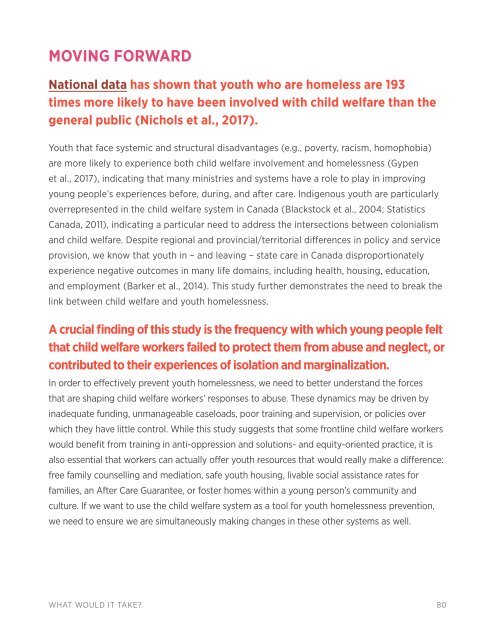COH-AWH-What_Would_it_Take
You also want an ePaper? Increase the reach of your titles
YUMPU automatically turns print PDFs into web optimized ePapers that Google loves.
MOVING FORWARD<br />
National data has shown that youth who are homeless are 193<br />
times more likely to have been involved w<strong>it</strong>h child welfare than the<br />
general public (Nichols et al., 2017).<br />
Youth that face systemic and structural disadvantages (e.g., poverty, racism, homophobia)<br />
are more likely to experience both child welfare involvement and homelessness (Gypen<br />
et al., 2017), indicating that many ministries and systems have a role to play in improving<br />
young people’s experiences before, during, and after care. Indigenous youth are particularly<br />
overrepresented in the child welfare system in Canada (Blackstock et al., 2004; Statistics<br />
Canada, 2011), indicating a particular need to address the intersections between colonialism<br />
and child welfare. Desp<strong>it</strong>e regional and provincial/terr<strong>it</strong>orial differences in policy and service<br />
provision, we know that youth in – and leaving – state care in Canada disproportionately<br />
experience negative outcomes in many life domains, including health, housing, education,<br />
and employment (Barker et al., 2014). This study further demonstrates the need to break the<br />
link between child welfare and youth homelessness.<br />
A crucial finding of this study is the frequency w<strong>it</strong>h which young people felt<br />
that child welfare workers failed to protect them from abuse and neglect, or<br />
contributed to their experiences of isolation and marginalization.<br />
In order to effectively prevent youth homelessness, we need to better understand the forces<br />
that are shaping child welfare workers’ responses to abuse. These dynamics may be driven by<br />
inadequate funding, unmanageable caseloads, poor training and supervision, or policies over<br />
which they have l<strong>it</strong>tle control. While this study suggests that some frontline child welfare workers<br />
would benef<strong>it</strong> from training in anti-oppression and solutions- and equ<strong>it</strong>y-oriented practice, <strong>it</strong> is<br />
also essential that workers can actually offer youth resources that would really make a difference:<br />
free family counselling and mediation, safe youth housing, livable social assistance rates for<br />
families, an After Care Guarantee, or foster homes w<strong>it</strong>hin a young person’s commun<strong>it</strong>y and<br />
culture. If we want to use the child welfare system as a tool for youth homelessness prevention,<br />
we need to ensure we are simultaneously making changes in these other systems as well.<br />
WHAT WOULD IT TAKE? 80
















